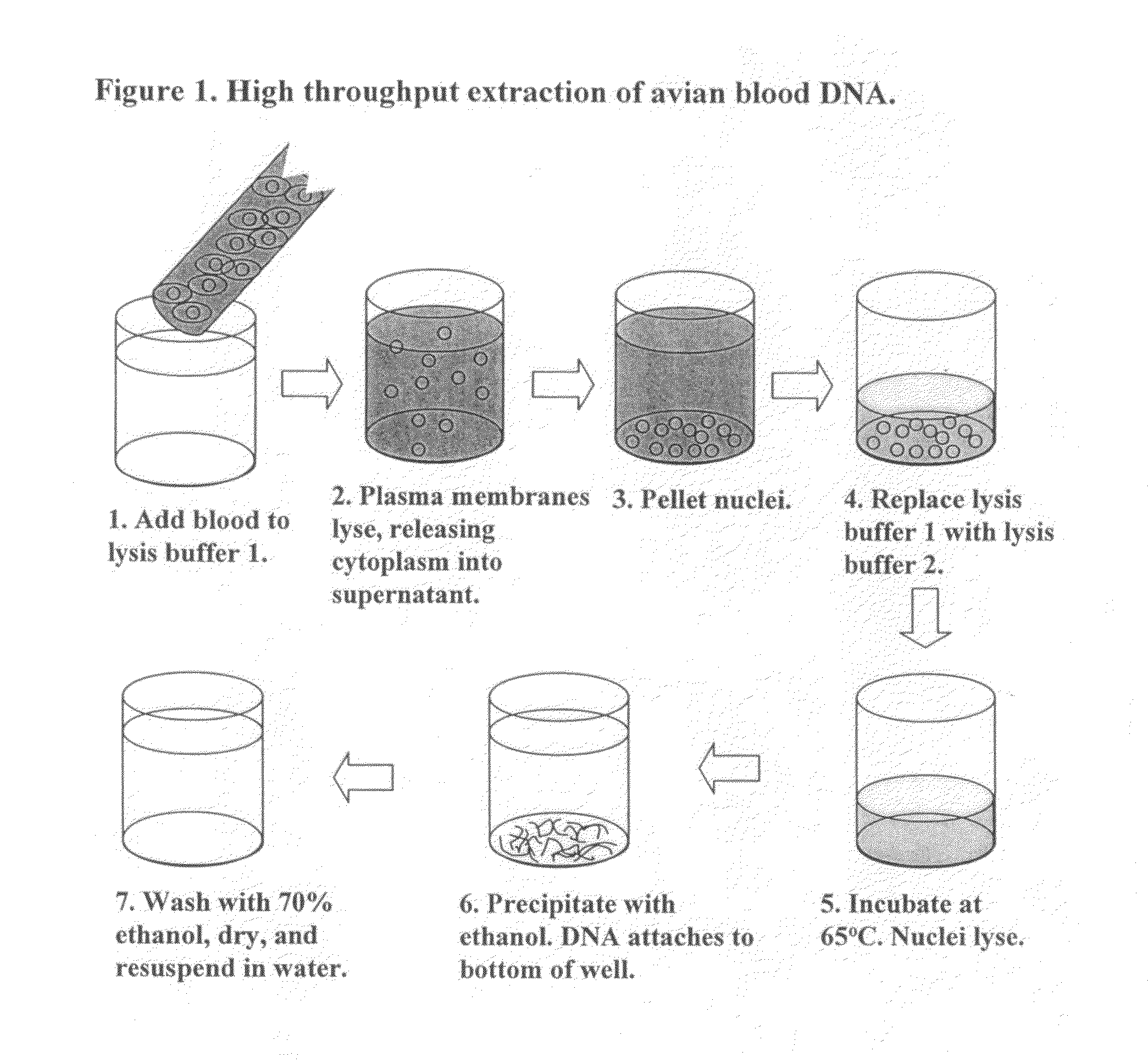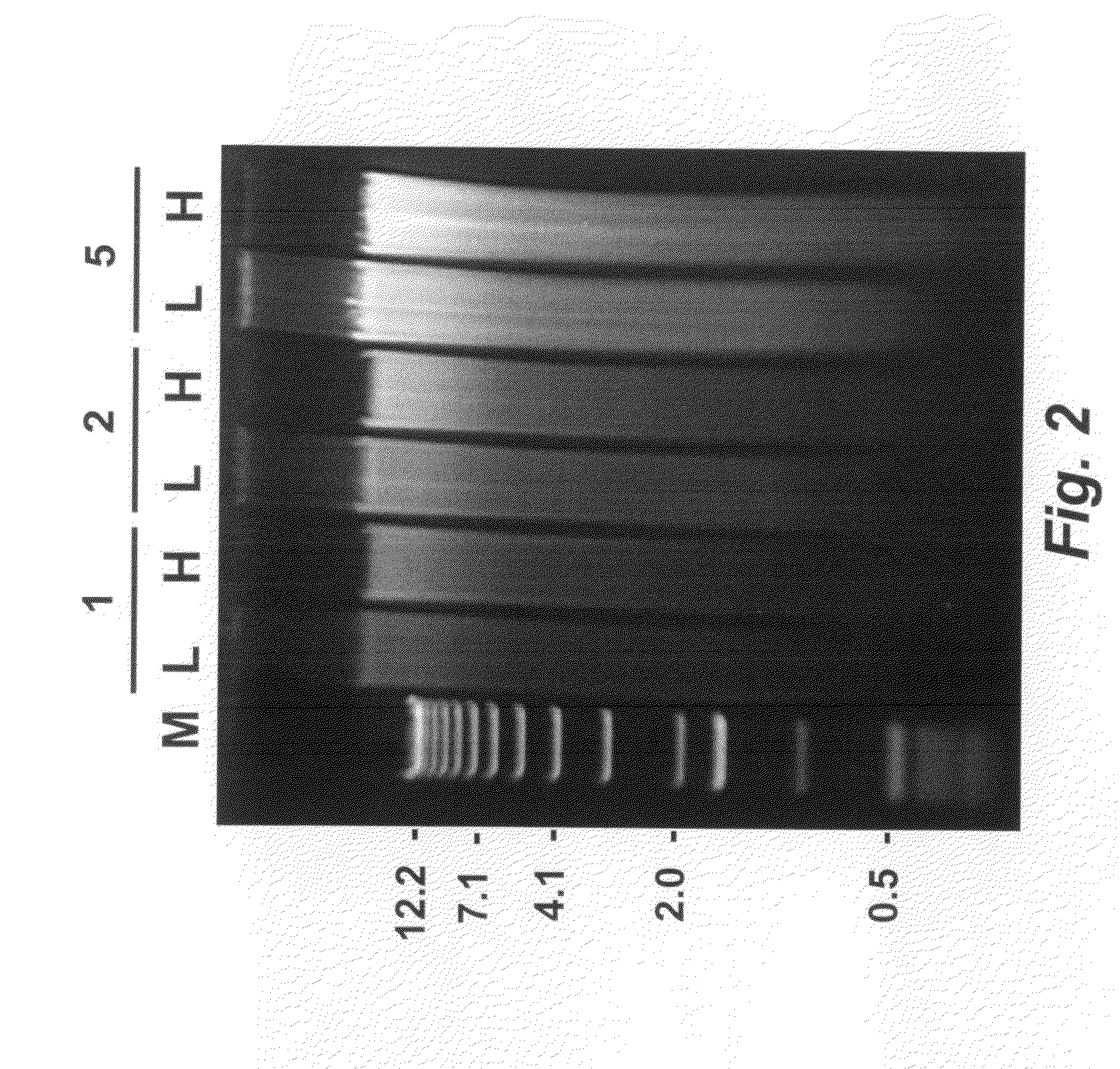Analysis of nucleic acid obtained from nucleated red blood cells
- Summary
- Abstract
- Description
- Claims
- Application Information
AI Technical Summary
Benefits of technology
Problems solved by technology
Method used
Image
Examples
example 1
DNA Extraction Method
[0052]Briefly, the protocol for DNA extraction from avian blood according to the present invention is as follows:[0053]A. To pre-chilled 96 well-flat bottom polystyrene tissue culture plates, 0.2 ml (can go as high as 0.25 ml) of lysis buffer LB1 (containing 0.32 M sucrose, 10 mM Tris-Cl, 5 mM MgC12, and 1% Triton X-100, at pH 7.5) was added to each well. Duplicate plates were set up for each set of 96 chicks. The 96-well plates were kept on ice until step C below.[0054]B. One to 10 day old White leghorn chicks were heated under a heat lamp to facilitate bleeding, and a heparinized 0.05 ml capillary tube (Fisher, Pittsburgh, Pa.) was filled half-full by pricking a leg vein. Over-filling the capillary tube will allow too much blood to go into the first 96-well plate. Upon filling the capillary tube, one drop (about 8 microliter or ¼th of the capillary) of blood was transferred into one well and its duplicate, each containing LB1. Following transfer, the blood and...
example 2
Average DNA Yield Using High Throughput DNA Extraction
[0067]Three separate DNA extraction experiments were conducted using blood samples obtained from White Leghorn chickens as described in Example 1 above. To quantify yield following high throughput extraction, 2 ul of DNA was added to 5 ul of Picogreen (Molecular Probes, Eugene, Oreg.) in 1.0 ml of TE buffer (containing 0.1 M Tris-base, and 0.005 M EDTA at pH 7.5). Samples were read on a Turner Designs TD-700 Fluorometer using CsCl-banded plasmid DNA quanitated by absorbance at A260 as a standard
[0068]Results of these experiments showed that 1 μl of DNA extracted and resuspended according to the high throughput method of the present invention typically contained 100 to 600 ng of genomic DNA. The average DNA yield was approximately 340 ng / μl+ / −120 ng / μl, as summarized in the following table:
Yield using High Througput DNA Extractionfrom Chicken Red Blood CellsAverageStandardNumber ofExperiment(ng / μl)deviationsamples1362.5116.0232357...
example 3
Identification of a GPDH Transgene in the Chicken Genome Using the High Throughput Assay
[0071]To demonstrate the compatibility of DNA extracted according to the present invention, two different TAQMAN assays were performed. First, a primer / probe set complementary to the chicken glyceraldehyde-3-phosphate dehydrogenase (GAPDH) was designed and made commercially. The primers were made at Gibco BRL (Gaithersburg, Md.) and the probe was synthesized by Operon Technologies (Alameda, Calif.). The primers used were designed as follows:
chGAPDH-1: 5′-TCCCAGATTTGGCCGTATTG-3′ (SEQ ID NO: 1) and
chGAPDH-2: 5′-CCACTTGGACTTTGCCAGAGA-3′ (SEQ ID NO: 2). The sequence of the chGAPDH probe was 5′-CCGCCTGGTCACCAGGGCTG-3′ (SEQ ID NO: 3). The chGAPDH probe was labeled with FAM (6-carboxyfluorescin) at the 5′ end and TAMRA (N,N,N′,N′-tetramethyl-6-carboxyrhodamine) at the 3′ end. The TAQMAN assay measures the increase of relative fluorescence due to hybridization of the chGAPDH probe to the PCR product and ...
PUM
| Property | Measurement | Unit |
|---|---|---|
| Time | aaaaa | aaaaa |
| Molar density | aaaaa | aaaaa |
| Molar density | aaaaa | aaaaa |
Abstract
Description
Claims
Application Information
 Login to View More
Login to View More - R&D
- Intellectual Property
- Life Sciences
- Materials
- Tech Scout
- Unparalleled Data Quality
- Higher Quality Content
- 60% Fewer Hallucinations
Browse by: Latest US Patents, China's latest patents, Technical Efficacy Thesaurus, Application Domain, Technology Topic, Popular Technical Reports.
© 2025 PatSnap. All rights reserved.Legal|Privacy policy|Modern Slavery Act Transparency Statement|Sitemap|About US| Contact US: help@patsnap.com



